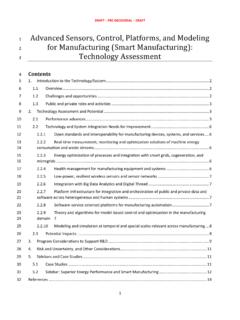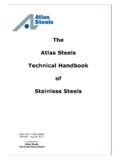Transcription of Hydrogen Compatibility of Materials - Energy
1 Hydrogen Compatibility of Materials August 13, 2013 DOE EERE Fuel Cell Technologies Office Webinar Chris San Marchi Sandia National Laboratories Sandia National Laboratories is a multi-program laboratory managed and operated by Sandia Corporation, a wholly owned subsidiary of Lockheed Martin Corporation, for the Department of Energy 's National Nuclear Security Administration under contract DE-AC04-94AL85000 SAND2013-6278P 2 Webinar Objectives Provide context for Hydrogen embrittlement and Hydrogen Compatibility of Materials Distinguish embrittlement.
2 Compatibility and suitability Examples of Hydrogen embrittlement Historical perspective Previous work on Hydrogen Compatibility Motivation of Materials Guide Identify the landscape of Materials Compatibility documents Motivation of the content of the technical Reference technical Reference for Hydrogen Compatibility of Materials Important strengths and limitations of the technical Reference Next steps: Tools for data management (database) 3 Provide context for Hydrogen embrittlement and Hydrogen Compatibility of Materials Distinguish embrittlement, Compatibility and suitability Examples of Hydrogen embrittlement Historical perspective Previous work on Hydrogen Compatibility Motivation of Materials Guide Identify the landscape of Materials Compatibility documents Motivation of the content of the technical Reference technical Reference for Hydrogen Compatibility of Materials Important strengths and limitations of the technical Reference Next steps.
3 Tools for data management (database) Webinar Objectives 4 1) Hydrogen -surface interactions: molecular adsorption and dissociation producing atomic Hydrogen chemisorbed on the metal surface 2)Bulk metal- Hydrogen interactions: dissolution of atomic Hydrogen into the bulk and segregation to defects in the metal ( , transport and trapping) 3) Hydrogen -assisted cracking: interaction of Hydrogen with defects changes local properties of the metal leading to embrittlement and possibly failure Science-based understanding of embrittlement enables innovation of Hydrogen technology Hydrogen embrittlement results from Hydrogen dissolving into metals and affecting their properties 5 What is Hydrogen Compatibility of Materials ?
4 Hydrogen Compatibility : Materials evaluation Standardized testing to determine Materials properties for design Hydrogen suitability: component evaluation There are multiple methods for establishing suitability: Performance test with gaseous Hydrogen to verify integrity of the component design or subsystem integration Design analysis to show structure accommodates the effects of Hydrogen on Materials properties 6 Environment Hydrogen partial pressure Temperature Gas impurities Stress Geometry Load cycle frequency Materials Composition Microstructure Hydrogen embrittlement occurs at the intersection of variables representing.
5 Environment Materials Stress / Mechanics Hydrogen Compatibility is the evaluation of the behavior of the Materials Hydrogen embrittlement is a degradation; Hydrogen Compatibility establishes suitability Hydrogen suitability is the management and control of these variables 7 Example: Hydrogen embrittlement in diaphragm compressor High-volume, two-stage diaphragm compressor Maximum output pressure: 70 MPa Used in Hydrogen containing environments Compressor adapted for high-purity Hydrogen system Second stage head failed after ~103 cycles Root cause analysis Material of construction: known to be very sensitive to Hydrogen embrittlement Service environment changed.
6 High-purity Hydrogen Hydrogen with impurities ( , oxygen) Hydrogen -assisted fatigue crack initiated at site of stress concentration 8 Example: Hydrogen embrittlement of pressure relief device Pressure relief device/valve (PRD) Activation pressure of ~54 MPa Operated successfully for many months System contains 17 identical valves No change in service environment Sudden failure of nozzle within PRD Root cause analysis Material of construction: known to be very sensitive to Hydrogen embrittlement Material did not meet specification: too hard/strong Cross section of undamaged nozzle (material.)
7 Type 440C) High-strength Materials are sensitive to Hydrogen embrittlement Hydrogen -induced crack 440C martensitic stainless steel 9 Webinar Objectives Provide context for Hydrogen embrittlement and Hydrogen Compatibility of Materials Distinguish embrittlement, Compatibility and suitability Examples of Hydrogen embrittlement Historical perspective Previous work on Hydrogen Compatibility Motivation of Materials Guide Identify the landscape of Materials Compatibility documents Motivation of the content of the technical Reference technical Reference for Hydrogen Compatibility of Materials Important strengths and limitations of the technical Reference Next steps: Tools for data management (database) 10 Historical perspective.
8 Large volume of work on Hydrogen by NASA contractors Data for a range of Materials captured in AIAA G-095, Guide to Safety of Hydrogen and Hydrogen Systems Extensively referenced for Hydrogen safety as well as Materials selection ( Compatibility ) NASA contractors developed method for ranking Materials based on notched tensile strength also: PM Ordin, NASA report no. NSS Data from: RP Jewitt et al, NASA report no. CR-2163 Does not: -provide explicit recommendation of Materials for Hydrogen -address usage of Materials ranked severe or extreme -account for fatigue 11 Historical perspective.
9 Investment in fuel cell technologies establishes new needs Motivation for structural Materials work in Hydrogen program Hydrogen Effects in Materials Laboratory at Sandia National Laboratories, Livermore CA Operational for several decades Unique mission, expertise and facilities Genesis of technical Reference for Hydrogen Compatibility of Materials DOE Hydrogen , Fuel Cells and Infrastructure Technologies Program Multi-Year Project Plan 2003 identified the need for a Materials guide for proper selection of Materials for Hydrogen service 12 Sandia s objectives for studying structural Materials for Hydrogen Energy Enable widespread commercialization by providing data for standards and technology applied to components for Hydrogen service Create Materials reference guide ( technical Reference )
10 And identify material property data gaps Execute Materials testing to meet immediate needs for data in standards and technology development Examples: measure properties of Hydrogen -exposed welds and Al alloys Improve efficiency and reliability of Materials test methods in standards Example: optimize fatigue crack growth testing in ASME Article KD-10 tank standard Participate directly in standards development Design and safety qualification standards for components SAE J2579, CSA HPIT1, ASME Article KD-10 (BPVC ) Materials testing standards CSA CHMC1 (Compressed Hydrogen Materials Compatibility )












